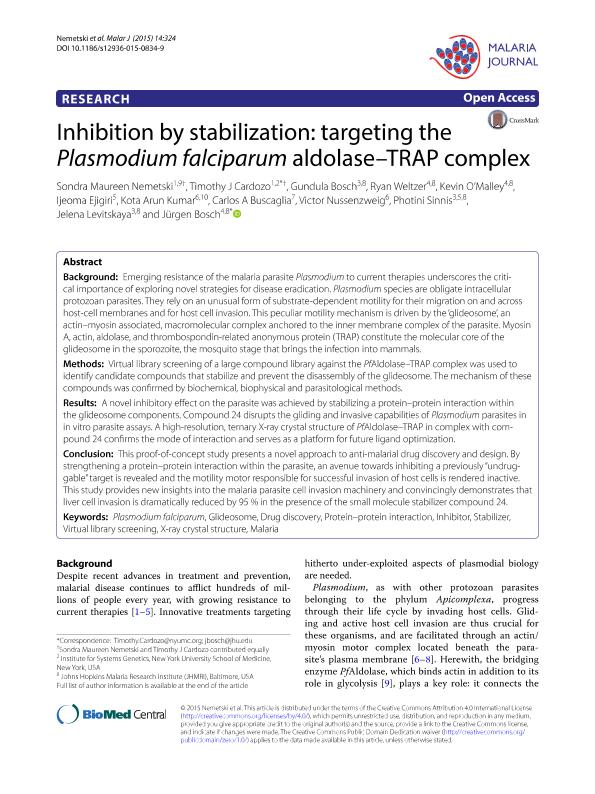Mostrar el registro sencillo del ítem
dc.contributor.author
Nemetski, Sondra Maureen
dc.contributor.author
Cardozo, Timothy J.
dc.contributor.author
Bosch, Gundula
dc.contributor.author
Weltzer, Ryan
dc.contributor.author
O'Malley, Kevin
dc.contributor.author
Ejigiri, Ijeoma
dc.contributor.author
Kumar, Kota Arun
dc.contributor.author
Buscaglia, Carlos Andres

dc.contributor.author
Nussenzweig, Victor
dc.contributor.author
Sinnis, Photini
dc.contributor.author
Levitskaya, Jelena
dc.contributor.author
Bosch, Jürgen
dc.date.available
2018-06-21T12:43:19Z
dc.date.issued
2015-08
dc.identifier.citation
Nemetski, Sondra Maureen; Cardozo, Timothy J.; Bosch, Gundula; Weltzer, Ryan; O'Malley, Kevin; et al.; Inhibition by stabilization: Targeting the Plasmodium falciparum aldolase-TRAP complex; BioMed Central; Malaria Journal; 14; 1; 8-2015; 1-18
dc.identifier.issn
1475-2875
dc.identifier.uri
http://hdl.handle.net/11336/49506
dc.description.abstract
Background: Emerging resistance of the malaria parasite Plasmodium to current therapies underscores the critical importance of exploring novel strategies for disease eradication. Plasmodium species are obligate intracellular protozoan parasites. They rely on an unusual form of substrate-dependent motility for their migration on and across host-cell membranes and for host cell invasion. This peculiar motility mechanism is driven by the 'glideosome', an actin-myosin associated, macromolecular complex anchored to the inner membrane complex of the parasite. Myosin A, actin, aldolase, and thrombospondin-related anonymous protein (TRAP) constitute the molecular core of the glideosome in the sporozoite, the mosquito stage that brings the infection into mammals. Methods: Virtual library screening of a large compound library against the PfAldolase-TRAP complex was used to identify candidate compounds that stabilize and prevent the disassembly of the glideosome. The mechanism of these compounds was confirmed by biochemical, biophysical and parasitological methods. Results: A novel inhibitory effect on the parasite was achieved by stabilizing a protein-protein interaction within the glideosome components. Compound 24 disrupts the gliding and invasive capabilities of Plasmodium parasites in in vitro parasite assays. A high-resolution, ternary X-ray crystal structure of PfAldolase-TRAP in complex with compound 24 confirms the mode of interaction and serves as a platform for future ligand optimization. Conclusion: This proof-of-concept study presents a novel approach to anti-malarial drug discovery and design. By strengthening a protein-protein interaction within the parasite, an avenue towards inhibiting a previously "undruggable" target is revealed and the motility motor responsible for successful invasion of host cells is rendered inactive. This study provides new insights into the malaria parasite cell invasion machinery and convincingly demonstrates that liver cell invasion is dramatically reduced by 95 % in the presence of the small molecule stabilizer compound 24.
dc.format
application/pdf
dc.language.iso
eng
dc.publisher
BioMed Central

dc.rights
info:eu-repo/semantics/openAccess
dc.rights.uri
https://creativecommons.org/licenses/by-nc-sa/2.5/ar/
dc.subject
Drug Discovery
dc.subject
Glideosome
dc.subject
Inhibitor
dc.subject
Malaria
dc.subject
Plasmodium Falciparum
dc.subject
Protein-Protein Interaction
dc.subject
Stabilizer
dc.subject
Virtual Library Screening
dc.subject
X-Ray Crystal Structure
dc.subject.classification
Otras Ciencias Biológicas

dc.subject.classification
Ciencias Biológicas

dc.subject.classification
CIENCIAS NATURALES Y EXACTAS

dc.title
Inhibition by stabilization: Targeting the Plasmodium falciparum aldolase-TRAP complex
dc.type
info:eu-repo/semantics/article
dc.type
info:ar-repo/semantics/artículo
dc.type
info:eu-repo/semantics/publishedVersion
dc.date.updated
2018-06-19T16:51:28Z
dc.journal.volume
14
dc.journal.number
1
dc.journal.pagination
1-18
dc.journal.pais
Reino Unido

dc.journal.ciudad
Londres
dc.description.fil
Fil: Nemetski, Sondra Maureen. New York University School of Medicine; Estados Unidos. New York-Presbyterian Hospital-Weill Cornell Medical College; Estados Unidos
dc.description.fil
Fil: Cardozo, Timothy J.. New York University School of Medicine; Estados Unidos
dc.description.fil
Fil: Bosch, Gundula. Johns Hopkins University Bloomberg School of Public Health; Estados Unidos. Johns Hopkins Malaria Research Institute ; Estados Unidos
dc.description.fil
Fil: Weltzer, Ryan. Johns Hopkins University Bloomberg School of Public Health; Estados Unidos. Johns Hopkins Malaria Research Institute ; Estados Unidos
dc.description.fil
Fil: O'Malley, Kevin. Johns Hopkins University Bloomberg School of Public Health; Estados Unidos. Johns Hopkins Malaria Research Institute ; Estados Unidos
dc.description.fil
Fil: Ejigiri, Ijeoma. New York University School of Medicine; Estados Unidos
dc.description.fil
Fil: Kumar, Kota Arun. New York University School of Medicine; Estados Unidos. University of Hyderabad; Estados Unidos
dc.description.fil
Fil: Buscaglia, Carlos Andres. Consejo Nacional de Investigaciones Científicas y Técnicas. Centro Científico Tecnológico Conicet - La Plata. Instituto de Investigaciones Biotecnológicas. Instituto de Investigaciones Biotecnológicas ; Argentina
dc.description.fil
Fil: Nussenzweig, Victor. New York University School of Medicine; Estados Unidos
dc.description.fil
Fil: Sinnis, Photini. Johns Hopkins University Bloomberg School of Public Health; Estados Unidos. New York University School of Medicine; Estados Unidos. Johns Hopkins Malaria Research Institute; Estados Unidos
dc.description.fil
Fil: Levitskaya, Jelena. Johns Hopkins University Bloomberg School of Public Health; Estados Unidos. Johns Hopkins Malaria Research Institute; Estados Unidos
dc.description.fil
Fil: Bosch, Jürgen. Johns Hopkins University Bloomberg School of Public Health; Estados Unidos. Johns Hopkins Malaria Research Institute; Estados Unidos
dc.journal.title
Malaria Journal

dc.relation.alternativeid
info:eu-repo/semantics/altIdentifier/doi/https://dx.doi.org/10.1186/s12936-015-0834-9
dc.relation.alternativeid
info:eu-repo/semantics/altIdentifier/url/https://malariajournal.biomedcentral.com/articles/10.1186/s12936-015-0834-9
Archivos asociados
